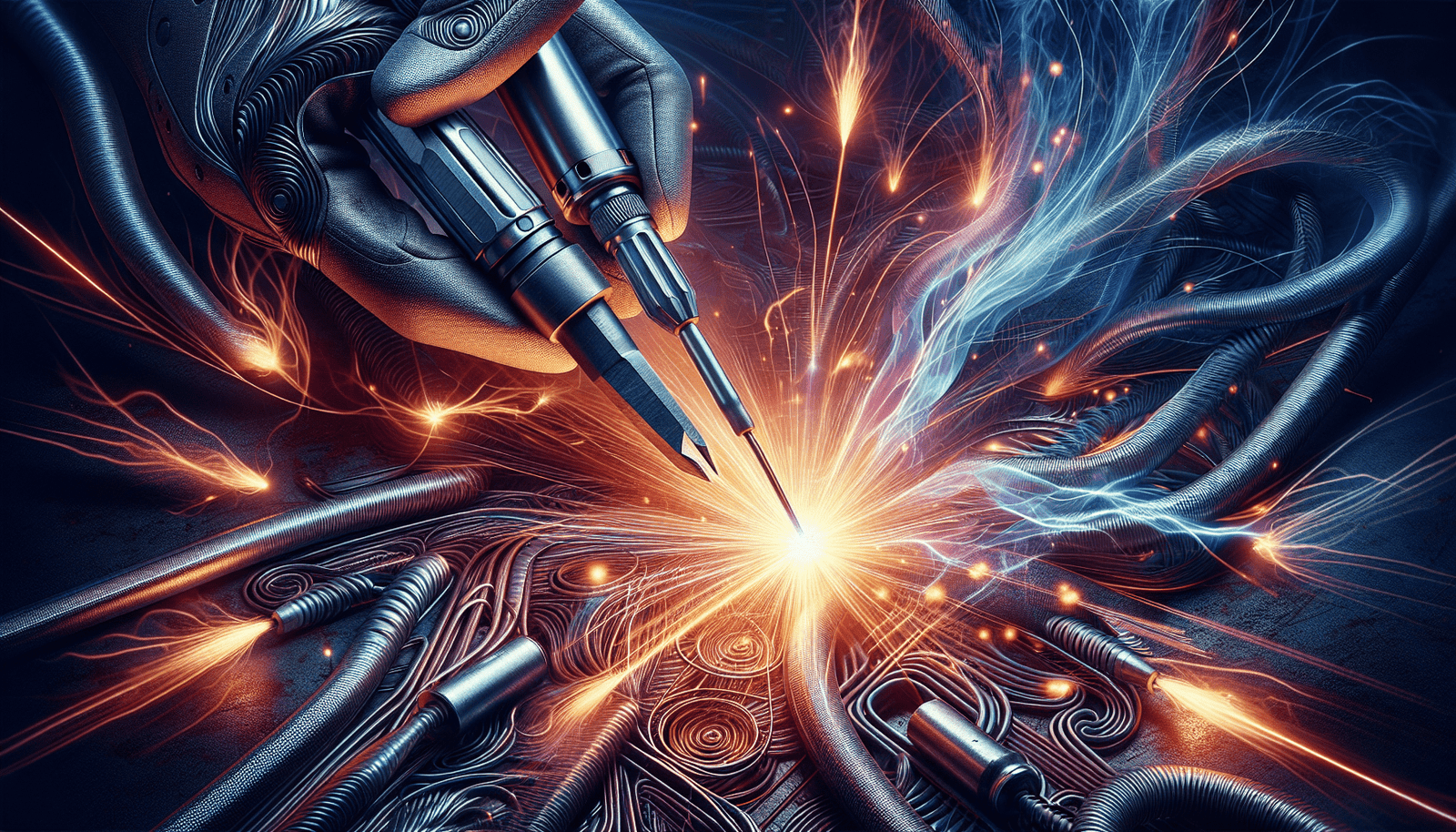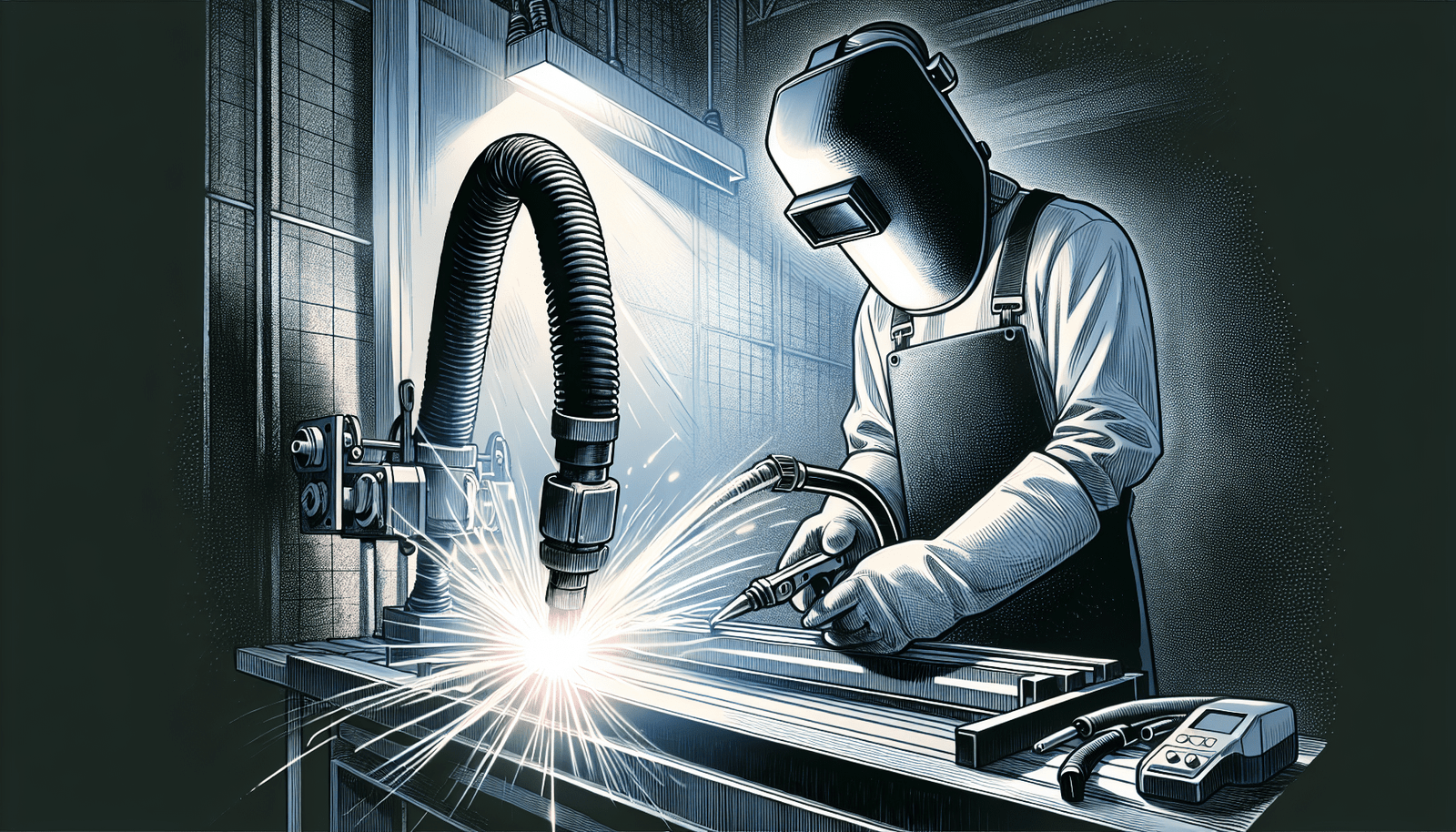Looking to embark on your welding journey but not sure about the different electrode sizes? Look no further! Our comprehensive Buyer’s Guide to Welding Electrode Sizes is here to help you navigate through the world of welding and make informed choices. Whether you’re a professional welder or a DIY enthusiast, this guide will provide you with all the information you need to understand the various electrode sizes available in the market. From the fundamentals to the intricacies, we’ve got you covered! So, let’s dive in and explore the world of welding electrode sizes together.
Understanding the Basics of Welding Electrodes
Welding electrodes are an essential component in the process of welding. They are consumable rods or wires that act as a filler material to join two pieces of metal together. Welding electrodes come in various sizes and types, each designed for specific applications and welding processes. In this article, we will explore the definition and function of welding electrodes, the significance of electrode sizes, the different types of welding electrodes, the specification of electrode sizes, factors to consider when choosing electrode sizes, the effects of electrode size on weld penetration and welding speed, the importance of electrode size in weld appearance, common mistakes to avoid when selecting electrode sizes, recommended brands for various electrode sizes, and concluding tips for selecting the right electrode size.
Definition of Welding Electrodes
Welding electrodes, also known as welding rods, are consumable devices utilized in the welding process to create an electric arc that generates the heat necessary to melt the base metals. They are made of a metal core with a flux coating that shields the weld area from contamination and provides the necessary properties for the weld. Welding electrodes come in various lengths, diameters, and compositions to suit different welding applications.
How Welding Electrodes Work
When an electric current is passed through a welding electrode, it creates a high-temperature arc that melts the electrode and the base metals. The molten metal from the electrode acts as a filler material, filling the gap between the two metal pieces and creating a solid joint upon solidification. The flux coating on the electrode produces a gas shield that protects the weld pool from atmospheric gases and impurities, preventing oxidation and ensuring a strong, high-quality weld.
Significance of Welding Electrode Sizes
Welding electrode sizes play a significant role in determining the outcome and efficiency of the welding process. The size of the electrode directly affects the welding current, arc stability, penetration depth, and deposition rate. Choosing the right electrode size for a particular welding task is crucial to achieve optimal weld quality, productivity, and appearance.
Types of Welding Electrodes
There are several types of welding electrodes available, each designed for specific welding processes and applications. The most common types include stick welding electrodes, TIG welding electrodes, MIG welding electrodes, and flux-cored electrodes. Let’s take a closer look at each type.
Stick Welding Electrodes
Stick welding electrodes, or shielded metal arc welding (SMAW) electrodes, are widely used and suitable for a variety of welding applications. They consist of a metal core wire and a protective flux coating. Stick welding electrodes are easy to use and can be used for welding both ferrous and non-ferrous metals. They are versatile and can handle thicker materials, making them popular in construction, repair work, and maintenance.
TIG Welding Electrodes
Tungsten inert gas (TIG) welding electrodes are primarily used in TIG welding, also known as gas tungsten arc welding (GTAW). TIG welding electrodes are made of pure tungsten or tungsten alloys, which have high melting points and excellent heat resistance. They do not dissolve into the weld pool and are therefore used for welding non-consumable materials like stainless steel, titanium, and aluminum. TIG welding electrodes offer precise control and produce high-quality welds with minimal spatter.
MIG Welding Electrodes
Metal inert gas (MIG) welding electrodes, also known as wire electrodes, are commonly used in MIG welding, also known as gas metal arc welding (GMAW). MIG welding electrodes are continuous wires that feed through a welding gun and melt into the weld pool. They are available in a wide range of compositions and thicknesses, making them suitable for various materials and applications. MIG welding electrodes are known for their high deposition rates, making them ideal for high-speed welding on thin materials.
Flux-cored Electrodes
Flux-cored electrodes are similar to MIG welding electrodes but have a flux-filled core instead of a solid wire. The flux within the electrode produces a shielding gas when it melts, which protects the weld pool from impurities. Flux-cored electrodes are commonly used for welding thick materials, outdoor applications, and in situations where it is challenging to establish a clean gas shield. They offer high productivity and are versatile in welding different metals and alloys.
Specification of Welding Electrode Sizes
Understanding the specification of welding electrode sizes is essential in selecting the right electrode for a specific welding task. The nomenclature and numbering system may vary depending on the electrode type and standards used. Let’s delve into the details of electrode nomenclature and the different electrode diameter sizes and their applications.
Understanding Electrode Nomenclature
Welding electrode nomenclature typically includes a combination of numbers and letters that provide information about the electrode’s characteristics. The first two digits represent the tensile strength of the weld deposit in thousands of pounds per square inch (psi). For example, a 60XXX electrode has a minimum tensile strength of 60,000 psi. The next digit or letter denotes the welding position, where ‘1’ stands for all positions, ‘2’ for flat and horizontal positions, and ‘3’ for flat position only. Additional letters or digits indicate specific properties such as the type of flux coating, current type (AC or DC), polarity, and composition.
Different Electrode Diameter Sizes and Their Applications
Welding electrode diameter sizes vary to accommodate different welding tasks, metal thicknesses, and joint configurations. Common electrode diameter sizes range from 1/16 inch to 3/4 inch, with 3/32 inch and 1/8 inch being the most widely used. Smaller diameter electrodes are suitable for thinner materials and out-of-position welding, while larger diameter electrodes are preferred for thicker materials and higher deposition rates. It is important to select the electrode diameter size that matches the specific welding requirements to achieve proper fusion and penetration.
Inspiring Factors for Choosing Electrode Size
Several factors should be considered when selecting the appropriate electrode size for a welding project. These factors include the type of metal being welded, the thickness of the metal, the type of welding process, and the current setting on the welding machine. Let’s explore each factor in more detail.
Type of Metal Being Welded
The type of metal being welded plays a crucial role in electrode size selection. Different metals have different thermal conductivity and melting points, requiring specific electrode characteristics and sizes. For example, when welding thin stainless steel, a smaller diameter electrode would be suitable to avoid excessive heat input and prevent burn-through. On the other hand, welding thicker carbon steel may require a larger diameter electrode to ensure sufficient penetration and deposition.
Thickness of Metal
The thickness of the metal being welded influences the choice of electrode size. Thicker materials generally require larger diameter electrodes to accommodate higher deposition rates and achieve proper fusion. Using a smaller electrode on thick metal may result in insufficient penetration and a weaker weld. Conversely, using a larger electrode on thin metal may cause excessive heat input, leading to distortion and burn-through. It is crucial to match the electrode size with the metal thickness to achieve a robust and structurally sound weld.
Type of Welding Process
Different welding processes have specific requirements for electrode size selection. Stick welding, for example, typically uses larger diameter electrodes to handle higher currents and provide deeper penetration. TIG and MIG welding, which are predominantly used for thinner materials, often require smaller diameter electrodes to achieve finer control and prevent overheating. Understanding the capabilities and limitations of each welding process is crucial in choosing the right electrode size for optimal results.
Current Setting on Welding Machine
The current setting on the welding machine largely affects the performance and characteristics of the electrode. Higher current settings require larger diameter electrodes to ensure stable arc initiation and maintain sufficient heat input. Conversely, lower current settings may necessitate smaller diameter electrodes to achieve precise control and avoid excessive heat input. It is essential to adjust the welding machine’s current setting according to the electrode size for consistent and effective welding.
Effects of Electrode Size on Weld Penetration
Weld penetration refers to the depth to which the weld extends into the base metal. It is an essential aspect of weld quality, as inadequate penetration can result in weak joints and reduced structural integrity. Electrode size plays a significant role in weld penetration. Let’s explore what weld penetration is and how electrode size influences it.
What is Weld Penetration?
Weld penetration, also known as weld depth or fusion depth, refers to the distance from the surface of the base metal to the deepest point of the weld fusion zone. It is influenced by various factors, including welding parameters, electrode size, joint design, and material properties. Proper weld penetration is crucial to ensure a strong and reliable joint.
How Electrode Size Influences Penetration
Electrode size directly affects weld penetration. Larger diameter electrodes have a higher current-carrying capacity and produce wider weld beads. They generate more heat and provide deeper penetration into the base metal. This is beneficial when welding thicker materials or in applications where increased weld strength is required. On the other hand, smaller diameter electrodes produce narrower weld beads with less heat input and shallower penetration, making them suitable for thinner materials and situations where excessive heat could cause distortion or burn-through. It is essential to choose the appropriate electrode size to achieve the desired weld depth and strength.
Importance of Electrode Size in Welding Speed
Welding speed, or the rate at which a weld is completed, is a crucial factor in many welding applications. The chosen electrode size significantly impacts welding speed. Let’s explore the relationship between electrode size and welding speed and how to choose the right electrode size for optimized welding speed.
Relation between Electrode Size and Welding Speed
The electrode size has a direct relationship with welding speed. Larger diameter electrodes can deposit more filler material per unit of time, allowing for higher welding speeds. This is advantageous when working on large-scale projects or welding thicker materials where productivity and efficiency are essential. Conversely, smaller diameter electrodes deposit less filler material and require more passes to achieve the required weld size, resulting in slower welding speeds. The choice of electrode size should consider the desired welding speed to complete the project within the specified time frame.
Choosing the Right Electrode Size for Optimized Welding Speed
To optimize welding speed, the appropriate electrode size should be selected based on the project requirements and the welding parameters. For applications where high deposition rates and fast welding speeds are critical, larger diameter electrodes are preferred. They allow for more efficient welding and can significantly reduce overall project time. However, it is important to strike a balance between welding speed and weld quality. Care should be taken to avoid sacrificing weld integrity and aesthetic appearance by selecting an electrode that is too large for the given application.
Electrode Sizes and Weld Appearance
The appearance of the weld is not solely determined by the skill of the welder but also influenced by the electrode size chosen. Let’s explore how electrode size affects the weld’s appearance and the welding techniques that can be employed to achieve a clean finishing.
How Electrode Size Affects Appearance of the Weld
Electrode size plays a significant role in the appearance of the weld. Larger diameter electrodes produce wider weld beads, which may result in a more pronounced and visible weld seam. This can be desirable in applications where weld appearance is not a significant concern, such as structural welding. On the other hand, smaller diameter electrodes produce narrower and more discreet weld beads, resulting in a weld with a cleaner and more aesthetically pleasing appearance. They are often preferred for applications that require a more refined finish, such as automotive or decorative welding.
Welding Techniques for a Clean Finishing
To achieve a clean finishing, certain welding techniques can be employed regardless of the electrode size. These techniques include maintaining a steady welding speed, using proper weaving patterns to distribute heat evenly, ensuring consistent arc length, and paying attention to the angle and position of the electrode. It is important to practice good welding techniques and apply them according to the specific welding requirements to achieve a visually appealing weld.
Common Mistakes to Avoid When Selecting Electrode Sizes
Selecting the wrong electrode size can lead to various issues, including weld defects, poor weld quality, and reduced productivity. Let’s highlight some common mistakes to avoid when choosing electrode sizes.
Choosing the Wrong Electrode Size for the Task
One of the most common mistakes is selecting the wrong electrode size for the welding task at hand. Using an electrode that is too large or too small for the material thickness, joint design, or welding process can result in inadequate penetration, excessive heat input, weld defects, and overall poor weld quality. It is important to carefully assess the welding requirements and match them with the appropriate electrode size to ensure a successful welding operation.
Not Considering Amp Rating of the Electrode
The amp rating of the electrode, which indicates the recommended welding current range, is often overlooked when selecting electrode sizes. Using an electrode outside its recommended amp range can lead to inconsistent arc stability, overheating, electrode sticking, and an increased risk of weld defects. It is crucial to refer to the manufacturer’s specifications and ensure that the chosen electrode size aligns with the appropriate amp rating for the welding machine.
Overlooking Material Thickness
Ignoring the material thickness when choosing an electrode size can result in weld defects and inadequate penetration. Using a larger electrode on thin materials can cause excessive heat input, leading to distortion and potential burn-through. Conversely, using a smaller electrode on thick materials may result in insufficient penetration and weak joints. It is vital to carefully consider the material thickness and select an electrode size that is compatible with the specific welding application.
Recommended Brands for Various Electrode Sizes
Choosing the right electrode size is not the only consideration when selecting welding electrodes. The brand of the electrode can also impact performance, quality, and reliability. Let’s compare some top electrode brands and discuss the relationship between price and quality in electrode brands.
Comparison of Top Electrode Brands
There are many reputable brands that offer high-quality welding electrodes. Some of the top brands in the industry include Lincoln Electric, ESAB, Hobart, Blue Demon, and Forney. These brands have established themselves as leaders in the welding industry, providing a wide range of electrode sizes and types to suit various applications. It is recommended to research and compare the offerings of different brands to choose the one that best meets specific welding needs.
Price vs Quality in Electrode Brands
When it comes to electrode brands, the price does not always reflect the quality. While some high-end brands command a higher price due to their reputation and advanced technology, there are also budget-friendly alternatives that offer reliable performance and quality. It is important to consider the specific welding requirements, budget constraints, and reviews from experienced welders when choosing an electrode brand. Balancing price and quality is essential to ensure a cost-effective and satisfactory welding experience.
Concluding Tips for Selecting Welding Electrode Sizes
Selecting the right electrode size is crucial for achieving optimal weld quality, efficiency, and appearance. To recap the key points discussed in this article, let’s summarize the tips for selecting welding electrode sizes:
- Understand the welding requirements, including the type of metal, thickness, joint design, and welding process.
- Refer to the electrode nomenclature and understand the significance of different electrode diameter sizes.
- Consider factors such as the type of metal, thickness, welding process, and current setting on the welding machine.
- Determine the desired weld penetration and adjust the electrode size accordingly.
- Balance between welding speed and weld quality by choosing the appropriate electrode size.
- Take into account the appearance requirements of the weld and select an electrode size that aligns with the desired finishing.
- Avoid common mistakes such as choosing the wrong electrode size, overlooking amp rating, and ignoring material thickness.
- Research and compare different electrode brands to find the one that offers the desired performance and quality.
- Balance the price and quality of electrode brands to ensure a cost-effective and satisfactory welding experience.
By following these tips, you can confidently select the right electrode size for your welding projects, ensuring successful and high-quality welds. Always prioritize safety and take necessary precautions when working with welding electrodes to protect yourself and others.




